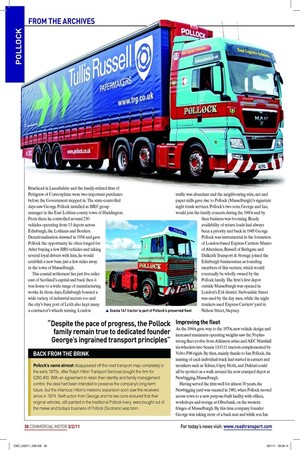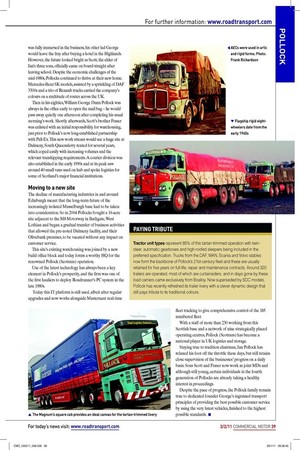All in the family
Page 30

Page 32

Page 33

If you've noticed an error in this article please click here to report it so we can fix it.
CM looks beyond the turquoise and red livery to find out how this family business has kept on top of its game
Words: John Henderson / Images: John Henderson /MAN First impressions are lasting impressions,
and that age-old saying can perhaps be equally applied to both people and commercial vehicles. Well into its eighth decade of operations, the trucks and trailers bedecked in Pollock (Scotrans)’s unique turquoise and red livery continue to turn the heads of many folk in our industry, together with leagues of interested onlookers. The Pollock family marked their 75th anniversary celebrations with a replica design of their original, 1930s art-deco-inspired livery applied to a new Volvo FH tractor unit (above). Unveiled at last August’s Truckfest Scotland extravaganza, this one-off special was arguably the star of the show. Further accolades for the Bathgate-based company would follow on swiftly when the tartan-trimmed leet was voted runner-up in the ‘Greatest British Hauliers’ poll, run by readers of our sister publication Truck & Driver.
Although he initially served an apprenticeship as a joiner, company founder William George Dunn Pollock had always been fascinated by transport. Even when repairing roofs in the late 1920s, this tradesman was continually distracted by passing lorries and, as a result, it was not unknown for him to strike a thumb with his hammer. After some driving experience with a local Edinburgh irm, George, as he was known to everyone, bought his own vehicle and ran from rented space at North Gyle Farm, in the capital’s western suburbs. In the early days, many of George Pollock’s ideas on vehicle designs could be seen to have come from the eye of a skilled tradesman. A correctly applied livery with perfect symmetry was required and this balance was carried over to the chassis too, with twin-opposing fuel tanks and spare wheels ixed dead centre at the back of the rails. Carefully constructed platform bodies also carried some superb design features way ahead of their time, in addition to allotted storage space for ropes, sheets and a steel tow bar.
Edinburgh calling
Prior to nationalisation in 1949, Pollock had expanded his smart leet and moved to larger premises in Gylemuir Road, Edinburgh. As extra licences were dificult to acquire then, acquisition of other transport businesses was a readily accepted practice at the time. Daniel Forrest of Braehead in Lanarkshire and the family-related irm of Pettigrew of Corstorphine were two important purchases before the Government stepped in. The state-controlled days saw George Pollock installed as BRS’ group manager in the East Lothian county town of Haddington. From there he controlled around 230 vehicles operating from 13 depots across Edinburgh, the Lothians and Borders. Denationalisation dawned in 1954 and gave Pollock the opportunity he often longed for. After buying a few BRS vehicles and taking several loyal drivers with him, he would establish a new base just a few miles away in the town of Musselburgh.
This coastal settlement lies just ive miles east of Scotland’s capital and back then it was home to a wide range of manufacturing works. In those days, Edinburgh boasted a wide variety of industrial sectors too and the city’s busy port of Leith also kept many
a contractor’s wheels turning. London ▲ Scania 141 tractor is part of Pollock’s preserved fleet
trafic was abundant and the neighbouring wire, net and paper mills gave rise to Pollock (Musselburgh)’s signature night trunk services. Pollock’s two sons, George and Ian, would join the family concern during the 1960s and by then business was booming. Ready availability of return loads had always been a priority and back in 1945 George Pollock was instrumental in the formation of London-based Express Carriers. Munro of Aberdeen, Russell of Bathgate and Dalkeith Transport & Storage joined the Edinburgh businessman as founding members of this venture, which would eventually be wholly owned by the Pollock family. The irm’s irst depot outside Musselburgh was opened in London’s E14 district. Stebondale Street was used by the day men, while the night trunkers used Express Carriers’ yard in Nelson Street, Stepney.
Improving the fleet
As the 1960s gave way to the 1970s, new vehicle design and increased maximum operating weights saw the 50-plusstrong leet evolve from Atkinson artics and AEC Marshall six-wheelers into Scania 110/111 tractors complemented by Volvo F86 rigids. By then, mainly thanks to Ian Pollock, the naming of each individual truck had started in earnest and monikers such as Telstar, Gipsy Moth, and Daktari could all be spotted on a walk around the now cramped depot at Newbigging, Musselburgh.
Having served the irm well for almost 30 years, the Newbigging yard was vacated in 1981, when Pollock moved across town to a new purpose-built facility with ofices, workshops and storage at Olivebank, on the western fringes of Musselburgh. By this time company founder George was taking more of a back seat and while son Ian was fully immersed in the business, his other lad George would leave the fray after buying a hotel in the Highlands. However, the future looked bright as Scott, the elder of Ian’s three sons, oficially came on board straight after leaving school. Despite the economic challenges of the mid-1980s, Pollocks continued to thrive at their new home. Mercedes-Benz SK models, assisted by a sprinkling of DAF 3300s and a trio of Renault trucks carried the company’s colours on a multitude of routes across the UK.
Then in his eighties, William George Dunn Pollock was always in the ofice early to open the mail bag – he would pass away quietly one afternoon after completing his usual morning’s work. Shortly afterwards, Scott’s brother Fraser was enlisted with an initial responsibility for warehousing, just prior to Pollock’s now long-established partnership with Pall-Ex. This new work stream would see a huge site at Dalmeny, South Queensferry rented for several years, which coped easily with increasing volumes and the relevant transhipping requirements. A courier division was also established in the early 1990s and at its peak saw around 40 small vans used on hub and spoke logistics for some of Scotland’s major inancial institutions.
Moving to a new site
The decline of manufacturing industries in and around Edinburgh meant that the long-term future of the increasingly isolated Musselburgh base had to be taken into consideration. So in 2004 Pollocks bought a 16-acre site adjacent to the M8 Motorway in Bathgate, West Lothian and began a gradual transfer of business activities that allowed the pre-noted Dalmeny facility, and their Olivebank premises, to be vacated without any impact on customer service.
This site’s existing warehousing was joined by a new build ofice block and today forms a worthy HQ for the renowned Pollock (Scotrans) operation.
Use of the latest technology has always been a key element in Pollock’s prosperity, and the irm was one of the irst hauliers to deploy Roadrunner’s PC system in the late 1980s.
Today this IT platform is still used, albeit after regular upgrades and now works alongside Masternaut real-time leet tracking to give comprehensive control of the 185 numbered leet.
With a staff of more than 230 working from this Scottish base and a network of nine strategically placed operating centres, Pollock (Scotrans) has become a national player in UK logistics and storage.
Staying true to tradition chairman, Ian Pollock has relaxed his foot off the throttle these days, but still retains close supervision of the businesses’ progress on a daily basis. Sons Scott and Fraser now work as joint MDs and although still young, certain individuals in the fourth generation of Pollocks are already taking a healthy interest in proceedings.
Despite the pace of progress, the Pollock family remain true to dedicated founder George’s ingrained transport principles of providing the best possible customer service by using the very latest vehicles, inished to the highest possible standards. ■













































